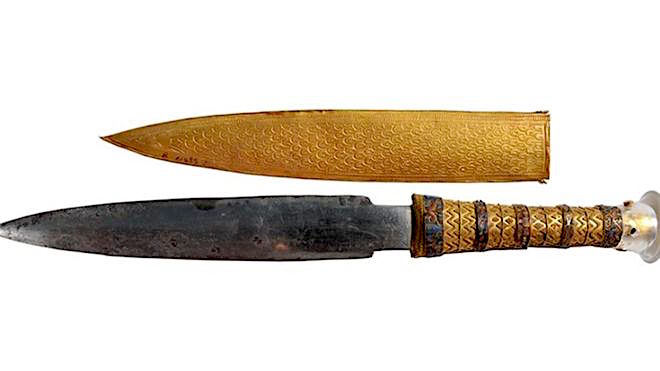
A dagger buried alongside legendary Egyptian King Tutankhamun was made with iron extracted from a meteorite, researchers have determined — a form of metal so prized by ancient Egyptians that they called it “iron from the sky.”
Using X-ray fluorescence spectrometry, a team of Italian and Egyptian experts led by Daniela Comelli of the Polytechnic University of Milan, analyzed the blade and found that it has a similar composition to metallic meteorites, the research published this week in the journal Meteoritics & Planetary Science shows.
The high manufacturing quality of the blade in comparison with other simple-shaped meteoritic artefacts suggests a significant mastery of iron working in Tutankhamun’s time, say researchers.
The dagger, which was discovered in 1925 among the folds of the wrapping around the mummified boy pharaoh, has long intrigued historians and archaeologists for both, its beauty and composition.
The piece, which has a gold and crystal handle, as well as an ornate sheath, has also has baffled scientists because iron was supposed to be a very rare metal used by ancient Egyptians.
This week’s paper confirms such a theory, as it says that the presence of iron —along with levels of nickel and cobalt — “strongly suggests an extraterrestrial origin.”
However, the high manufacturing quality of the blade in comparison with other simple-shaped meteoritic iron artefacts “suggests a significant mastery of ironworking in Tutankhamun’s time”, the researchers say.

Tutankhamun’s dagger. (Image courtesy of Wiley Online Library)
They compared the composition of the dagger to known meteorites within 2,000km around the Red Sea coast of Egypt, and found that one in particular — which landed 240km (150 miles) west of Alexandria — contained similar levels of nickel and cobalt.
Probably one of the best known pharaohs of ancient Egypt, Tutankhamun was a minor figure in ancient Egyptian history. The boy king of the 18th Egyptian dynasty reigned eight to nine years and accomplished little, but the discovery of his nearly intact tomb in 1922 has led many to attempt unravel the mystery of his life and death.
His dagger can currently be seen at the Egyptian Museum in Cairo.
4 Comments
Rod B
Having “a similar composition to metallic meteorites” does not mean the blade was fashioned from a meteorite, and finding a meteorite “having similar levels of nickel and cobalt” does not prove anything.
I find this “story” hard to believe. Next thing you know, they will find mastodon tracks on the top of the pyramid blocks!
esqualido
They weren’t into alloying metals in those days
Material Scientist
Take a look at what I just posted. Hopefully that will help you understand they are just saying it’s meteoritic because it sounds like a cool store. Material Science is awesome.
Material Scientist
There are several factors that come into play to determine if a metal is from space. The ratio of metals and the particular isotopes are important, but crystal grain size is the ideal test. A metallic allow that is from space would have macroscopic crystal grain boundaries because the metal cooled extremely slowly in space. Iron produced on earth has nano scale grain boundaries as a result of the rapid rate the metal cools.
It’s a simple process to examine the metal under microscope and measure the grains. It would take PID controlled annealing ovens and tremendous amounts of electricity to “fake” this, which means it’s more likely to be genuine meteoritic iron.
The composition in this case, is not being used to answer the question “is this a meteorite?” but rather, “is this a piece of a known meteorite sample from the region? or is this a new specimen?”
See these images so it’s clear what is meant by grain boundaries. If you slice the metal with a diamond saw, exposing a flat surface, the grains are revealed.
http://www.ssina.com/images/corrosion/IGAFig1.jpg
Steel – The grains are so small, that to even see them under microscope,
you have to etch the metal with acid so that the edges of each grain corrode)
Meteoritic Iron – You don’t even need a microscope because of the gigantic crystal grains
http://cdn.zmescience.com/wp-content/uploads/2013/05/widmanstatten.jpg
http://www.kdmeteorites.com/images/Campo%20Collection/c1.JPG
http://d-scholarship.pitt.edu/6290/1/M_R_Allazadeh(Jan-2009).pdf
This paper shows the type of equipment needed to control cooling rate and grain size from the melt phase to solid. Doubtful the ancients had this type of process control tech.